Joylene Nowell Butler's Blog, page 9
August 20, 2020
How to Write Really Bad Fiction and Enjoy the Benefits of Rapid Rejection
by Hank Quense
I’m an author of twenty books — both fiction and non-fiction — and over forty short stories along with a number of fiction writing articles. From my experience, I’ve learned a number of important lessons and I want to pass them onto others. One important lesson involves getting a book published; it changes your life. No longer can you sit in your office and spend your time writing more fiction. Once you become a published author, you also become the book’s marketing manager and its sales manager, a terrifying situation if you’re not prepared for it. It’s enough to force some people to go get a real job instead of writing.
To protect others from the trauma of this situation, I’ve put together a list of fiction writing techniques that will guarantee non-publication. Following them will ensure a rapid reply from editors who will use a preprinted form or a terse email. This rapid reply will allow you to maximize the rejections you receive in a given period of time.
Here is the list in no particular order:
Always use adverbs! Lots and lots of adverbs. One of your writing objectives should be to use an adverb to modify at least fifty percent of your verbs. And don’t forget about using them in dialog tags. Why show the reader a woman shredding a paper tissue? Make it easy on the poor readers. Tell them the woman is nervous. Thus, “He’s making me so fidgety,” she said nervously.
A naked noun is evil! Adjectives exist to be used. Their primary purpose is to modify a noun, so make use of this most excellent writing technique. Load up your nouns with modifiers so the reader will have no doubts about the noun. “The skinny, ugly guy wore a hideous, ripped t-shirt, dirty, baggy pants and shredded sneakers.” Here’s an even better example of clever adjective usage: “The scrawny boy used his undersized biceps to try to pick up the clumsy weight and place it in the old-fashioned truck before the foul-mouthed old man became aware of his clever trickery.” Get the idea? Remember, a naked noun is e-v-i-l!
Use conversation. Don’t limit yourself to dialog. Conversation is the stuff of life. Don’t allow your characters to be stuck inside the story by restricting them to dialog that moves the story forward. Make your characters more life-like by letting them engage in idle conversation just like real people do.
” How you doing?”
“I’m cool. What’s up?”
“I’m good. Couldn’t be better. Watching the Yankees tonight?
“Who they playing? . . . Yada, yada, yada.”
This stuff doesn’t move the story along like dialog does, but it shows the characters are just as boring as real folk.
Motivation is overdone. To properly show motivation requires a lot of creativity, time and words. It is much better to skip over that part and get right into the action. So what if the guy disarming the ticking bomb is only doing it because his shift doesn’t end for two hours and he doesn’t have anything better to do. The character doesn’t have any motivation, but who cares; it keeps the story moving and doesn’t slow it down with a lot of words explaining the motivation.
Don’t worry about Point of View rules. POV is perhaps the most technical of all aspects of writing and handling it correctly is time-consuming and requires advanced planning. Who needs all that extra work when there is another scene to write or another crisis to defuse. Most of the readers will figure it out and sort of follow the story.
It’s wise to develop writing habits such as peppering the page with -ing words. This technique will give your writing a pleasing sing-song effect. “Opening the door and running down the corridor while waving her hand, she tried shouting, calling attention to her life-threatening situation.” Doesn’t that sentence make you want to hum along from all the -ing words?
Use empty words. Very, really, ever, still, just and others are words with no meaning but they do fill up sentences and make them look more impressive. Fiction writing is filled with opportunities to use these words and titillate the readers. With a bit of imagination, you can also use these words to punctuate the sentence.
Why bother with multiple-dimensional characters? Flat characters work just as well. Flat characters can fight, love and die just as well as the more complicated ones, but take considerably less work. The simple approach gives you more time to write still more stories.
Character Voice. This attribute allows the reader to identify the characters from their dialog “voices.” What nonsense. That’s what names are for. Just use the names in all the lines of dialog and the readers will be able to keep the characters straight.
Keep this list near your keyboard and refer to it frequently. Within a short time, your friends and family will be impressed by the huge stack of rejection notices you’ve accumulated. Soon you’ll be able to claim that you are an “Internationally rejected author.” A side benefit is that your family will know you’re really doing something in your office. Right now, they probably think you’re goofing off and playing computer games.
If you chose to ignore this excellent advice, there are alternatives listed in my book, Creating Stories. Note that following the advice in that book can significantly increase the response time from editors.

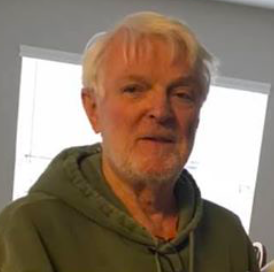
For vacations, Hank and Pat usually visit distant parts of the galaxy. Occasionally, they also time-travel.
Besides writing novels, Hank lectures on fiction writing, publishing and book marketing. He is most proud of his talk showing grammar school kids how to create a short story. He used these lectures to create an advanced ebook with embedded videos to coach the students on how to create characters, plots and settings. The target audience is 4th to 7th graders. The book’s title is Fiction Writing Workshop for Kids.

The post How to Write Really Bad Fiction and Enjoy the Benefits of Rapid Rejection appeared first on Joylene Nowell Butler.
August 8, 2020
Phyllis Zimbler Miller – Modeling Good Behavior
Writers Modeling Behavior On and Off the Page
On July 17, 2020, The Wall Street Journal published humor columnist Jason Gay’s article “Please Wear a Mask So I Can Shut Up About Wearing Face Masks.”
The subhead was: “I’m as tired of this discussion as anyone else. So let’s mask up and make progress.”
Now why would I choose to talk about this subject in my monthly guest post for author Joylene Nowell Butler? What does this have to do with writing?
I often blog about the responsibility of writers to portray in their writing safer sex and other safe behavior (when it doesn’t hinder an important plot point). And I believe it is equally important for writers — who should understand the impact people’s actions have on other people (that is what we write about, don’t we?) – to also model responsible behavior in real life.
There’s a concept in Judaism about not appearing to do wrong. Here’s how that concept could be applied in today’s world:
Let’s say you live where masks are mandated if you can’t social distance. You are leaving your house to take the dog for a walk and don’t plan to come near anyone else.
Picture the scenario so far?
Now you (with your dog) go off without a mask. You know you’ll cross the street if anyone else comes walking towards you on the same side of the sidewalk.
But the people who see you walking without a mask don’t know what a good citizen you plan to be. They just think 1) you’re an asshole for not wearing a mask or 2) you don’t think it is necessary – and maybe they don’t need to wear a mask either.
And that’s an example of the concept of appearing to do wrong.
To make my point using humor of how little an effort it is to wear a mask, I’m going to quote from Jason Gay’s article (boldface mine):
“But look at the new cases, friends. We’re still in this battle, and there’s something we all can do: Wear the mask.
“You’ve heard it a bajillion times, but here’s the basic idea: If you’re going to be indoors in a building that is asking you to wear a mask, wear a mask. If you’re in a crowd and not able to be socially distant, wear a mask.
“That’s it! That’s all that’s being asked here. I’m not asking you to help me move. I’m not asking you to drive me to the airport. I don’t think I’m going to the airport until 2041.”
I do believe as writers we have a responsibility to model good behavior for others. After all, we write for others. Shouldn’t we care about others in our daily lives? And today that means wearing masks!
If you want to add in the comments below other examples that demonstrate the concept of not appearing to do wrong, please do so. We can all learn something new.

 Phyllis Zimbler Miller is an author and screenwriter in Los Angeles. She can be reached through her website at www.PhyllisZimblerMiller.com
Phyllis Zimbler Miller is an author and screenwriter in Los Angeles. She can be reached through her website at www.PhyllisZimblerMiller.com
Phyllis Zimbler Miller
Screenwriter * Author
www.linkedin.com/in/phylliszimblermiller
http://twitter.com/ZimblerMiller
Skype: PhyllisZimblerMiller12
Member of Women in FilmMember of the Dramatists GuildMember of Military Writers Society of America
The post Phyllis Zimbler Miller – Modeling Good Behavior appeared first on Joylene Nowell Butler.
August 1, 2020
IWSG August 2020 – Winter Light by Martha Engber
Good morning, everyone. Thank you for visiting my blog. Today I’m excited to announce that Winter Light by Martha Engber is available for preorder. I love this book so much I’ve chosen not to answer this month’s question. I’m also postponing posting more escapades of my 2019 Bali trip until next month–the novel is that good.
It’s been a while since I read the final draft of Winter Light, but the storyline is still vivid in my mind. From the start I wanted Mary to succeed. I needed her to succeed. It’s not that she sabotages her chances, but Mary Donahue, disillusioned and suspicious, has learned to rely on no one. During the scene where Kathleen’s mum tries to reach out to help Mary, I choked up. I’ve learned the importance of accepting help, Mary hasn’t. There’s another part where she lands herself in a dangerous situation with some very scary people; honestly, I felt my blood pulsating through my veins.
I’m fortunate to have some wonderful and talented online friends; Martha Engber is one of them. I’ve been a huge fan since before her first novel THE WIND THIEF was published. That’s why it’s such a privilege to announce the release of her newest novel, Winter Light.
If you’re passionate about writing, study Martha’s novels. Check out her blog for workshops and seminars. Martha has spent years helping other writers. I promise if you learn one thing from this wonderful author, your writing will improve significantly.
Links:
Martha’s Blog: https://www.marthaengber.com/
Amazon: https://www.amazon.com/Winter-Light-Martha-Engber-ebook/dp/B08DC8XY66/ref=sr_1_1?dchild=1&keywords=Winter+Light&qid=1596475822&s=books&sr=1-1
Goodreads: https://www.goodreads.com/book/show/54339436-winter-light
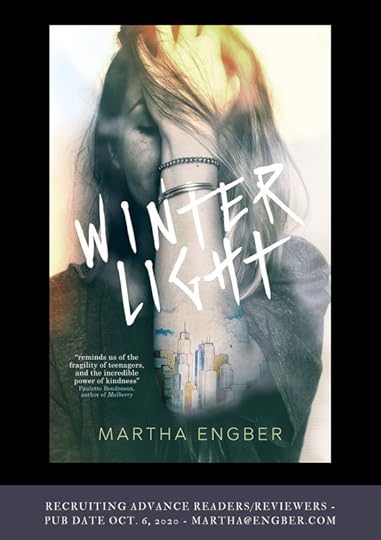

Fifteen-year-old Mary Donahue of suburban Chicago is a kid on the cusp of failure during the brutal blizzard winter of 1978-79, the end of a hard luck, hard rock era sunk in the cynical aftermath of the Vietnam War.
Though a smart, beautiful kid, she’s a motherless girl raised by an uneducated, alcoholic father within an extended family of alcoholics and addicts. Aware that she’s sinking, she’s desperate to save herself and so reaches out to an unlikely source, Kathleen, a nice, normal kid from English class.
But when the real storm hits, the full force of a harsh adult world almost buries Mary. Only then does she learn that the only difference between life and death is knowing when to grasp an extended hand.
Product detailsFormat: Kindle EditionFile Size: 3391 KBPrint Length: 148 pagesSimultaneous Device Usage: UnlimitedPublisher: Vine Leaves Press (Oct. 6 2020)Sold by: Amazon.com Services LLCLanguage: EnglishASIN: B08DC8XY66

Another release I’m honoured to share with you is Keep Writing With Fey: Sparks to Defeat Writer’s Block, Depression, and Burnout. If you’ve ever felt hopeless, depressed, or stuck as a writer, this book is a must-read.
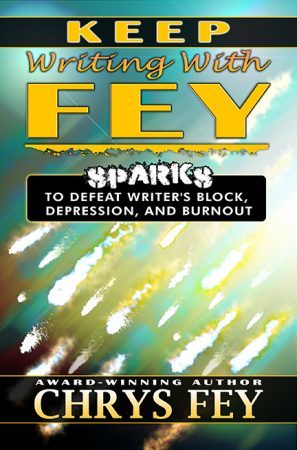

Catch the sparks you need to conquer writer’s block, depression, and burnout!
When Chrys Fey shared her story about depression and burnout, it struck a chord with other writers. That put into perspective for her how desperate writers are to hear they aren’t alone. Many creative types experience these challenges, battling to recover. Let Keep Writing with Fey: Sparks to Defeat Writer’s Block, Depression, and Burnout guide you through:
Writer’s blockDepressionWriter’s burnoutWhat a writer doesn’t need to succeedFinding creativity boostsWith these sparks, you can begin your journey of rediscovering your creativity and get back to what you love – writing.
Release date – July 14, 2020
$17.95, 6×9 trade paperback, 256 pages
Print ISBN 9781939844729 / EBook ISBN 9781939844736
Writing / Self-Help: Depression – Stress Management
Chrys Fey is the author of the Disaster Crimes Series and an editor for Dancing Lemur Press. She started her blog, Write with Fey, to offer aspiring writers inspiration, advice, and hope. At the age of twelve, she started writing her first novel, and since then she has been a dedicated citizen in the writing world.
Links:
Amazon – https://www.amazon.com/Keep-Writing-Fey-Writers-Depression-ebook/dp/B0849R9S8R/
Barnes & Noble – https://www.barnesandnoble.com/w/keep-writing-with-fey-fey-chrys/1136384744?ean=9781939844743
ITunes – https://books.apple.com/ca/book/keep-writing-with-fey/id1497044824
Kobo – https://www.kobo.com/us/en/ebook/keep-writing-with-fey
Goodreads – https://www.goodreads.com/book/show/50983917-keep-writing-with-fey


IWSG was created by Ninja Captain Alex J Cavanaugh — because Alex understands we need a safe place to congregate, insecurity is part of our creative nature, and together we’re stronger.
On the first Wednesday of each month, you can write on any subject related to your writing journey or adopt the option of answering the month’s question. Either way, you’re in safe territory.
If this sounds like a good place to be, sign up here.
IWSG’s Twitter handle is @TheIWSG and hashtag is #IWSG.
Every month, a question is announced that members can answer in their IWSG post. These questions may prompt you to share advice, insight, a personal experience or story. Include your answer to the question in your IWSG post or let it inspire your post if you are struggling with something to say.
Remember, the question is optional!
August 5 question – Quote: “Although I have written a short story collection, the form found me and not the other way around. Don’t write short stories, novels or poems. Just write your truth and your stories will mold into the shapes they need to be.”Have you ever written a piece that became a form, or even a genre, you hadn’t planned on writing in? Or do you choose a form/genre in advance?
The awesome co-hosts for the August 5 posting of the IWSG are Susan Baury Rouchard, Nancy Gideon, Jennifer Lane, Jennifer Hawes, Chemist Ken, and Chrys Fey!–namastejoylene
The post IWSG August 2020 – Winter Light by Martha Engber appeared first on Joylene Nowell Butler.
July 20, 2020
Introducing WritersARC
by Hank Quense
I’ve been writing stories for over 20 years. I’ve been self-publishing for over ten. I’ve also been lecturing for more than ten years. Over time, I’ve created a wealth of material on these topics and I’ve often considered collecting in a library of some sort for writers and authors who were looking for advice.
I finally did it. I established a separate section on my website dedicated to all this material, most of it previously published but scattered all over the web and some of it new, created expressly for this new project.
The Writers and Authors Resource Center (WritersARC) is a unique collection of material on three topics: fiction writing, self-publishing and book marketing. The mind-map shows the organization of the website.
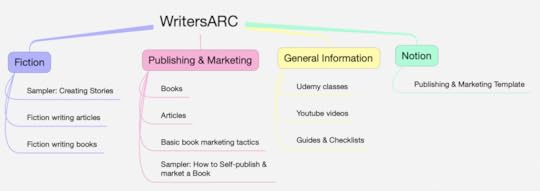
The Notion website has auxiliary pages for material that can’t be added to a WordPress site. Currently, it has a Kanban-style task list covering a self-publishing and book marketing project. More material will follow.
You can find the main page for this collection here: http://hankquense.org/wp/writers-and-authors-resource-center/
This webpage has links to all the other pages.
Currently, it has the following pages:
• Basic book marketing
• Fiction writing books
• Fiction writing articles
• Sampler: How to Self-publish and Market a Book
• Publishing and marketing articles
• Publishing and marketing books
• Udemy classes
• Videos
• Guides & checklists
• Sampler: Creating Stories
• Project Plan: Self-publishing and Marketing a Book
You may want to bookmark the main page and come back because I plan to add a lot more material to the WritersARC. This planned material won’t be the usual, run-of-the-mill type of stuff. It will be different.


For vacations, Hank and Pat usually visit distant parts of the galaxy. Occasionally, they also time-travel.
Besides writing novels, Hank lectures on fiction writing, publishing and book marketing. He is most proud of his talk showing grammar school kids how to create a short story. He used these lectures to create an advanced ebook with embedded videos to coach the students on how to create characters, plots and settings. The target audience is 4th to 7th graders. The book’s title is Fiction Writing Workshop for Kids.

The post Introducing WritersARC appeared first on Joylene Nowell Butler.
July 10, 2020
Phyllis Zimbler Miller – Writers and Cultures
Can Writers Authentically Write About Cultures Other Than Their Own Cultures?
I do not intend this blog post as a political essay. Rather the post is a jumping-off point for a discussion about this especially relevant question now.
On a Hollywood Reporter roundtable of screenwriters (available on YouTube), Kasi Lemmons – the African-American screenwriter of the 2019 film HARRIET about Harriet Tubman – said that she believed writers could write about other cultures as long as the writers did extensive research.
To me writing about other cultures includes experiencing those other cultures.
For example, my women’s friendship novel MRS. LIEUTENANT – inspired by my own experiences – features four female POV characters – a Northern Jew, a Southern Baptist, an African-American, and a Puerto Rican. The characters are composites of actual women I knew, and I flushed out their backstories with research.
When I later wrote a short story, PINKY SWEAR, about the Puerto Rican female in MRS. LIEUTENANT as a teen, I also used composite characters and research.
I’m currently working on a limited series TV project about slavery. I have been warned that I could face criticism (and attacks) as a white person writing about the evils of slavery. Yet for me, if you believe in the importance of a project, you must be willing to accept attacks.
When I was a newspaper journalist interviewing diverse people, my job was to make my articles about those people truthful and compelling. I often interviewed people whose lives were very different from my own.
Although I often did not come from the same cultural background, I only needed to truly try to understand the cultural background of the person whom I interviewed.
Having given these above examples as background for this blog post, I come to the central question of this blog post:
Should only people of a specific cultural background be entitled to write about people of that same background?
In a Zoom conversation a few days ago with someone to whom I was introduced through the platform Lunchclub, the person said something very interesting in relation to this topic. The gist of his remarks? Saying only these people can write about these people and only those people can write about those people is actually a form of segregation that promotes discord rather than unity.
I have been thinking of his remarks as I read more and more news accounts about the ideological stance of one group demanding precedence over the ideological stance of another group on questions such as the one I’ve raised here.
And to be clear, this question is not one that should be considered lightly. Although it calls for careful consideration, I would like to present one incredibly powerful example on the side of writers being able to write authentically about other cultures.
The non-Jewish American writer and journalist John Hersey (1914-1993) wrote numerous novels on important historical topics including his novel THE WALL about fictional Jewish characters imprisoned in the Warsaw Ghetto who struggle to survive the Nazis’ death grip.
THE WALL is one of the most compelling fictional works that I have ever read. I would hate to think that Hersey might have decided not to write this novel because 1) he wasn’t Jewish and 2) he hadn’t been one of the few Jews to survive the Warsaw Ghetto.
In conclusion, now is the time for you to weigh in on this topic. Joylene and I invite you to utilize the comments section below.
And if you’d like to sign up for Lunchclub conversations (free at the time of writing) click here. (This is my invite link to share with others as you currently need an invite link to join.)

 Phyllis Zimbler Miller is an author and screenwriter in Los Angeles. She can be reached through her website at www.PhyllisZimblerMiller.com
Phyllis Zimbler Miller is an author and screenwriter in Los Angeles. She can be reached through her website at www.PhyllisZimblerMiller.com
Phyllis Zimbler Miller
Screenwriter * Author
www.linkedin.com/in/phylliszimblermiller
http://twitter.com/ZimblerMiller
Skype: PhyllisZimblerMiller12
Member of Women in FilmMember of the Dramatists GuildMember of Military Writers Society of America
The post Phyllis Zimbler Miller – Writers and Cultures appeared first on Joylene Nowell Butler.
July 1, 2020
July 2020 – The Long Flight to Bali
I went to southeast Asia in October by myself. I chronicled the first part of my trip in my May post: Encountering Manila. In June IWSG: […]Bali, I shared my first day. I hope you’ll check out the links. The Philippines and Indonesia are beautiful countries and very desirable destinations for obvious reasons.
But before I begin, due to the quarantine and the extreme heat, I’m feeling lethargic, and I’d like to apologize because I think my writing reflects that. I’m certainly not inspired by it. WestJet cancelled our 4th attempt at flying home for the summer. The only non-WestJet flight I could find will take 3 days (2 overnight layovers) in some of the worst corona hotspots on the continent. That sounds scary and reckless. But can we withstand the heat if we decide to stay?
We had a cooler than normal winter and several mornings I had to wear a sweater. The wind off the bay kept our little apartment cool, sometimes even cold — until Father’s Day. Then as warned, the wind died. Unless you’ve experienced the shift, there’s no way of preparing for it. We’re Canadians and, as such, we don’t do well in the heat. I still haven’t finished my WIP. I can’t concentrate for more than 20 minutes at a time. I’m behind in my chores, I’m not exercising. I’m unmotivated. My writing seems choppy. I’m napping during the day.
But enough of my whining …
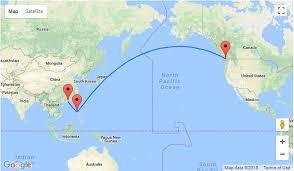
My trip to Bali spanned over 2 days. In late September, I drove from New Brunswick to Manitoba, by myself, then flew to Vancouver. Why? Long story for another day. I keep mentioning “by myself” because it was a huge deal for me. Driving across Canada, then flying to the south pacific. I’d never done anything like this before. Except for the time I drove our motorhome from Whitehorse, Yukon down to Prince George, BC.
When reality set in I almost decided to cancel the trip. Winter was coming. The trip through Ontario can at times be treacherous. I changed my itinerary, drove to Manitoba, flew to Vancouver, and left from there; which saved me 4 hours. If you’re not up on your geography, Vancouver is a 2-hour drive north from Seattle. Winnipeg is about 6 hours north of Bismarck.
I left Canada on October 1 and arrived in Manila at 5:00 am on October 3.
October 2 was spent at 30,000+ feet.
I’m mentioning this because it’s important to take note of how very long these flights are.
If you hope to see the south pacific one day, consider Business Class if possible. And travel at night. The planes have small seats. The best are in the exit isles; however, there are metal armrests that don’t move, and although you have extra legroom, you are snug like a bug in a rug, and only able to recline the seat an inch. You’re sitting upright for what feels like days. It’s uncomfortable. I’m 5’5 and was the tallest person on the plane. While Business is over double the cost, I bet it’s worth the comfort.
Also, pack light. As I mentioned last month, security is tight. When they tell you to be at the airport 4 hours prior to take-off, you’ll need every minute to get through all the checkpoints. A backpack and a carryon make for quicker inspections; and really, they’re all you need. If that sounds ludicrous, check out the many videos on YouTube on how to survive long flights.
I had planned on sharing my week’s experience at the Blooming Lotus Yoga Bliss retreat in Ubud, but I’ve decided to cut this short and continue in August. Otherwise, you’ll be here all day. And there are so many awesome IWSG bloggers to visit.
Below are some of the photographs I took of the country on our way to the retreat. I was like a kid with my face pressed to the glass. I’d never seen such a contrast in foliage and architecture and landscapes. It made me think of all the young men during the Vietnam War and what they experienced the moment they stepped out of the cargo planes.
As we drove toward my destination and my driver explained as best he could in broken-English what I was seeing, I couldn’t help feeling overwhelmed with gratitude.

My GPS said 53 minutes, but it was more like 65 minutes in traffic.

Below is Krishna Arjuna Statue. My photo from the backseat doesn’t do it justice. The road is too busy to stop.

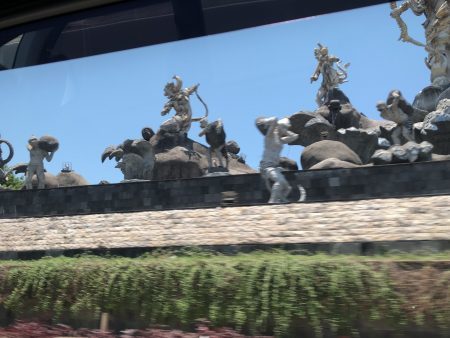
Similar to North America, there are temples instead of churches on almost every corner.



They’re kites below. Some sort of special event going on. The kites are the shape of fighter planes.

I’m not exactly sure, but I think this is the entrance to a park or a hotel, some type of tourist spot.
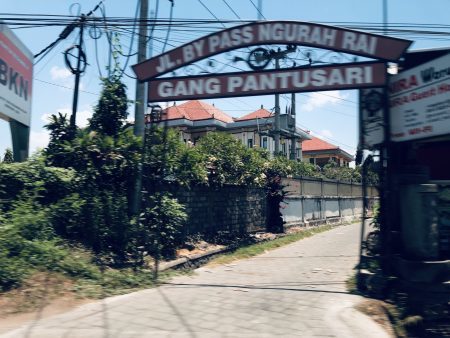

The monument below honours Satria Gatot Kaca, a legendary and powerful knight who is believed to give spiritual protection and safety for all incoming and outgoing flights.
One of the busier corners. Haha, I know, where’s the traffic?


Scooters are very popular on the island. It’s said there are over 2 million. I think I saw a few hundred thousand.


Dewa Indera Statue, stands at the junction of the road to Ubud. The colours were brilliant.

Rice paddles along the road.

Many temples.


Many, many scooters. 

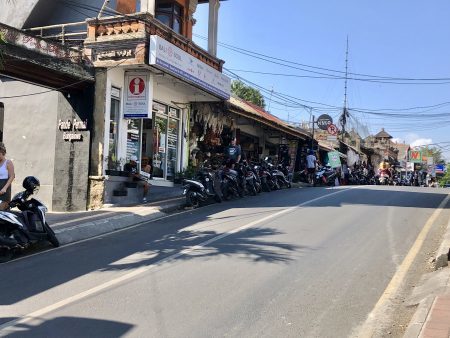



One day a friend from the retreat and I were walking past the entrance to the Monkey Forest. My friend was eating an ice-cream cone. I wasn’t. She was behind me when I heard a loud scream. One of the monkeys had climbed onto her back and was trying to steal her cone. One of the guards yelled a command in a very menacing voice and the monkey jumped down and ran into the forest.
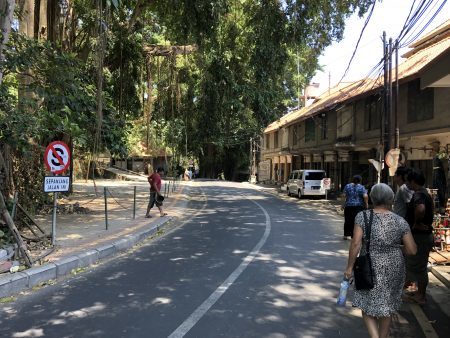

I asked why some of these goddesses have so many arms and I was told it’s because they represent the power of God.



IWSG was created by Ninja Captain Alex J Cavanaugh — because Alex understands we need a safe place to congregate, insecurity is part of our creative nature, and together we’re stronger.
On the first Wednesday of each month, you can write on any subject related to your writing journey or adopt the option of answering the month’s question. Either way, you’re in safe territory.
If this sounds like a good place to be, sign up here.
IWSG’s Twitter handle is @TheIWSG and hashtag is #IWSG.
Every month, a question is announced that members can answer in their IWSG post. These questions may prompt you to share advice, insight, a personal experience or story. Include your answer to the question in your IWSG post or let it inspire your post if you are struggling with something to say.
Remember, the question is optional!
July 1 question – There have been many industry changes in the last decade, so what are some changes you would like to see happen in the next decade?The awesome co-hosts for the July 1 posting of the IWSG are Jenni Enzor, Beth Camp, Liesbet, Tyrean Martinson, and Sandra Cox!— namaste
joylene
The post July 2020 – The Long Flight to Bali appeared first on Joylene Nowell Butler.
June 20, 2020
Book Blurbs: A Marketing Opportunity by Hank Quense
In online writing groups and on Goodreads, I often see requests for comments on an author’s book blurb. In almost every case, this book blurb is really a short synopsis. I believe a short synopsis and a book blurb are two completely different documents.
A short synopsis goes on the inside flap of the cover on a print book while the book blurb goes on the back cover. With ebooks and paperback, the book blurb goes on the book’s webpage followed by the short synopsis.
A book blurb is a marketing tool designed to attract a potential buyer’s attention. In other words, it can be used to differentiate the author’s book.
Differentiation, or the book blurb, is an important element in a marketing plan. It is a versatile tool and has many uses. It is also a key element in converting potential readers to book buyers and it’s a start on building your brand..
So, the question is: What is a book blurb? Well, the blurb is a three-part statement about your book. These statements tell the world why your book matters and why readers should buy it. Essentially, what it entails is creating three sentences or short paragraphs that can be used to help sell your book.
Here are descriptions of each of the three elements.
Pitch Line: this is the first statement and it is the hook to grab the readers’ attention. Its purpose is to persuade the reader to keep reading the other two statements. It should be simple, one or two sentences at most, and it must make a clear statement about your book.
What’s in it for the buyer? is a statement that explains what the reader (i.e. a book buyer) will get in exchange for money. This must be explicit. This statement is not the place to get cute. Don’t come across like the legendary used-car salesman. Tell the readers what benefit they’ll get from buying the book. Think of this statement in this way; if your book is surrounded by hundreds of similar-sized books on a shelf in a bookstore, what would persuade the buyer to choose your book instead of one of the others?
What’s different about this book? With all the books published every month, what makes your book stand out from the others?
These dry descriptions are difficult to grasp so I’ll use examples from my published books: one non-fiction and one fiction.
Creating Stories uses these three statements.
Pitch line: Do you have a story in you? Do you know how to write it or how to tell it?
What’s in it for the buyer? Creating Stories has the answers. Hank Quense, the author of more than twenty books, tells you how to do it.
What’s different about this book? Quense believes that stories come from the melding of three creating stories processes: getting ideas, story design and story-telling. Ideas have to come from the author. Creating Stories covers the last two.
Here is the fiction example. For my novel, Falstaff’s Big Gamble, I developed this book blurb.
Pitch Line: This novel is Shakespeare’s Worst Nightmare.
What’s in it for the buyers? It takes two of the Bard’s most famous plays, Hamlet and Othello, and recasts them into Gundarland. There, Hamlet becomes a dwarf and Othello a dark elf
What’s different about this book? If that isn’t bad enough, these two tragedies are now comedies with Falstaff, Shakespeare’s most popular rogue, thrown in as a bonus.
When you use your differentiation statements, don’t use the term “pitch line” or the questions. Just have the statement flow into a short paragraph
So what are the differentiation statement good for? How can they be used? You can use it anywhere it’ll fit. If you can’t fit the entire statement someplace (such as on Twitter), use the pitch line by itself.
Here are some common uses.
On a website: On your book-buying web page, make the pitch line the opening statement followed by the rest of your differentiation message. Why? On the internet, attention spans are too minuscule to measure. When visitors land on your web page, you have a second or two to persuade them to read beyond the first line of text they see. That is the job of your pitch line: to get the visitors to read the rest of the blurb.
Trailers: Make sure your differentiation statements are clearly visible and emphasized in the trailer. Get the message in the beginning and the end of the trailer. Innumerable people from all over the world may view the trailer and you want them to understand your message.
Internet Announcements: Log onto social media sites and post an announcement that your book will be or is available. Include the blurb in the opening part of the announcement. Use it on book sites like Goodreads. After the blurb, add information about your book. You can upload the cover image and add descriptive text about it.
Press Releases: Display your differentiation message prominently. Make it the opening statement in the body of the release. Rephrase it and place it a second time further down in the body.
Sig Files: Use the signature capability in your email program to build a unique signature using the pitch line by itself. Link that pitch line to a book-seller website. Now, every time you send an email, you’ll also be pitching your book.
Once you’ve used the book blurb as a marketing tool, you’ve taken a big step toward getting people to buy your book. The blurb will also start to build your brand.
Keep going! You can do this.


For vacations, Hank and Pat usually visit distant parts of the galaxy. Occasionally, they also time-travel.
Besides writing novels, Hank lectures on fiction writing, publishing and book marketing. He is most proud of his talk showing grammar school kids how to create a short story. He used these lectures to create an advanced ebook with embedded videos to coach the students on how to create characters, plots and settings. The target audience is 4th to 7th graders. The book’s title is Fiction Writing Workshop for Kids.
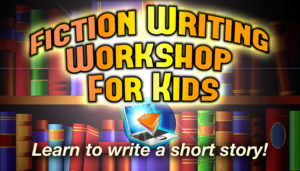
The post Book Blurbs: A Marketing Opportunity by Hank Quense appeared first on Joylene Nowell Butler.
June 10, 2020
Phyllis Zimbler Miller – Social Media Responsibility in the Time of Plague
In the online world that most of us have been “living in” for the last several weeks — the updates on social media have become a main source of interaction.
And yet many people do not realize the possible harm that can result from their fired-off tweets, Facebook comments, etc.
First, there is the ease with which we share tweets or posts or even newspaper articles without knowing whether this shared information is accurate. As someone pointed out to me, one of the reasons my husband and I continue to disagree over what is happening is that we utilize different news sources.
When I earned a B.A. in Journalism at Michigan State University, we were taught to be objective. That journalism mandate now appears to have flown out the window.
Thus even if we personally are committed to not fanning the flames by spreading misinformation, we may be unintentionally doing so.
Second, there’s the intentional spreading of our own views, which of course we are entitled to do. Yet, we do need to act responsibly. If we are for or against what the President has just said or done, we need to express our opinions in ways that will not inflame the situation. We need to be constructive.
For example, I was very upset by the June 1st photo I saw of Trump, the Secret Service and others striding out of the White House grounds on their way to a church in DC. Not one person wore a mask except for a woman way back in the throng who was barely visible. What a terrible “message” about the need for continued safety precautions against COVID-19.
Now if I had tweeted what idiots all these people were, what good would that have done? Better if I had tweeted the photo with the accompanying comment that it is important to remember to wear masks and practice social distancing in our own activities. (I actually didn’t tweet about this photo, although I sent it to a dear friend because I was so upset at the lack of masks and social distancing.)
And then there’s the issue of simply sharing the photo on social media. Even if I had added a comment about the negative behavior in the photo, as pictures speak louder than words, I would have been sharing a photo that appears to suggest that masks and social distancing are no longer needed.
Okay, although I realize this is a lot of discussion on one photo, I do think it is a good example of how we have to think of the possible unintended consequences before we click “retweet” or “share” on social media.
And then there’s the question of social media making us feel unhappy about ourselves …
Until I attended an in-person event (long before the COVID-19 lockdowns) at which Jessica Abo spoke about her book UNFILTERED: HOW TO BE AS HAPPY AS YOU LOOK ON SOCIAL MEDIA, I had no idea that other people’s “shares” on social media could be distressful.
As Abo pointed out, when someone posts a photo of a beautifully prepared salmon dish, what isn’t posted are photos of the messy kitchen, the sauce that burned the pan, the earlier mistakes that had to be tossed. (It would be more responsible for the poster to admit the effort it took to achieve this “perfect” dish.”)
Now especially in this anxiety-prone era we should consider not posting things without an explanation so that we don’t make others feel badly.
And as to feeling badly, we need to remind ourselves that photos have been “doctored” probably since the beginning of photography. We shouldn’t be so hard on ourselves when we see “perfect” photos and info shared on social media.
That said, I’m going back to my compulsive reading of COVID-19 headlines on cnn.com – and trying to stay calm in the midst of uncertainty.
Wishing you all good health and that you are staying safe ….

 Phyllis Zimbler Miller is an author and screenwriter in Los Angeles. She can be reached through her website at www.PhyllisZimblerMiller.com
Phyllis Zimbler Miller is an author and screenwriter in Los Angeles. She can be reached through her website at www.PhyllisZimblerMiller.com
Phyllis Zimbler Miller
Screenwriter * Author
www.linkedin.com/in/phylliszimblermiller
http://twitter.com/ZimblerMiller
Skype: PhyllisZimblerMiller12
Member of Women in Film
Member of Military Writers Society of America
The post Phyllis Zimbler Miller – Social Media Responsibility in the Time of Plague appeared first on Joylene Nowell Butler.
June 3, 2020
June 2020 – IWSG: Tuban, Kuta, Bandung, Bali
I’m posting part two of my trip to Southeast Asia in lieu of answering this month’s question. But before I begin, I’d like to share something.
In 2018, through different methods, I not only succeeded in managing my body pain, I eliminated much of the pain in my back, hips, knees and feet. It was miraculous.
In 2019, I pledged to heal my spirit. When negative thoughts entered my mind, I observed them without prejudice then released them to the sky as if they were balloons. When I couldn’t, I meditated. Life was beautiful and I was happier than I’d ever been.
In March the pandemic struck, and over time, my resolve wore down and I allowed unhealthy thoughts to affect my body and my mind, threatening to undo all the good I’d accomplished in 2018 and 2019. I let fear seep into my life. I let negativity into my bones, onto my skin, and in my gut. When the riots broke out to the north, I sat in silence, glued to the television. I felt sick to my stomach. I felt useless.
Monday night I woke in a sweat, unable to catch my breath; it was as if someone was sitting on my chest. I walked out onto the terrace, shifting the invisible weight onto my shoulders. The air was thick with heat. I could hear waves rumbling to shore; the occasional sound of traffic on Tepic Highway 200. The moon was small. The palm trees silent.
Nothing profound happened, yet, I felt compelled to stand there and wait. Perhaps because in the past if I was still long enough, some revelation would eventually tiptoe across my mind.
Sure enough. One word. A whisper: “Smile.” And I remembered: it starts with me. I may not be able to cure racism or create a vaccine. But there is something I can do.
“To everything there is a season, and a time to every purpose under the heaven.”
Five years ago, if someone I barely knew said they loved me, I was suspicious. When one of my favourite rockstars shouted from the stage, “I love you guys,” my first thought was you’re stoned. That may well have been true, but I’ve since learned that love is universal. It’s not just a word. Love is in our DNA. You don’t have to know someone to love them. You love them because, whether we like it not, we’re connected. We are “one”.
I’m sending love now as I type. I’m doing it even though I understand that not everyone will feel my sincerity. It’s not for me to question why. I’m here as a work-in-progress to say: I care about you. I hope you sense it. I accept you for who you are. When we’re dead, we will recognize each other, and it won’t be because of the colour of our skin or the words out of our mouths or because of the way we died.
Namaste: The light inside of me sees the light inside of you.

Last month I shared my impressions of Manila in my IWSG post. I hope you get a chance to read it. I shared then and I’m sharing now for three reasons. One: I want to share. Two: I want to record my thoughts for my great-grandchildren and possibly their great-grandchildren. Three: If you’re undecided about ever taking a trip by yourself, I hope you’ll reconsider.

I checked out of The Luneta in Manila, on Saturday, October 5, 2019, at 16:35 (4:35).


If you’re planning a trip to Southeast Asia, please heed the warning to be at the airport four hours prior to take-off. Ninoy Aquino Airport has four terminals. It really does take four hours to get through the checkpoints. Although I’ve been to the United States many times, I have never experienced the stringent security that I witnessed in Manila. I had only a backpack and a small carry-on. At each checkpoint, they were inspected. I had to remove my laptop and I had to have my backpack weighed. While several gate agents let me pass despite my backpack being a pound over, I wasn’t so lucky by the third checkpoint and had to pay a hefty fee of fifty bucks! Ouch.

Novotel Hotel is in the village of Tuban, a subdistrict of Kuta, a subdistrict of Badung Regency. The area is best known for its stunning beaches. After my upcoming retreat in Ubud, I stayed near the beach where the Indian Ocean meets the path flow of the Pacific Ocean. Yes, it was heavenly. Again–a huge thank you! to Noreen Coley at Paull Travel.
[image error]
Today, the population of Bali is approximately 680,000, covering an area of 5,780 square kilometres. About the size of Lake Winnipegosis, Canada’s 11th largest lake. The population of Kuta is 200K.
Tourism didn’t take hold in Bali until the 60s, thanks to the Hippies. In the 1830s Kuta was an important slave market that attracted much of the world’s “scum”.

My first sight once I got off the plane. The hotel is somewhere inside the airport.
[image error][image error]I’m not an excitable person by nature, but I was excited standing in line at midnight, waiting to get through customs. It had been a 3 and a half-hour flight, so my back and my feet felt pretty good.
It was fascinating to see and hear all the different nationalities. I counted 10 different languages in my immediate area. I didn’t take any photos because by then my battery was dead.
I spent only one night at the Novotel Bali Airport Hotel (Bali Denpasar International Airport) and was so impressed, I’m giving it its own post.


Hotel Novotel, rear entrance

I finished with customs shortly before one in the morning. The hotel was there somewhere. I looked for signs. By then I was exhausted and my eyesight was blurry. A young, uniformed gentleman approached and offered assistance. I asked if he could please point me in the direction of the Novotel Hotel. He grabbed my carry-on and my backpack and said he would take me there.


The gardens outside


During our ten minute walk, we chatted. He was born in Bali, his family lived in the north, and he saw his mother at least once a month. He worked 6 days a week. I sensed a dedicated, gentle, and kind young man. When we reached the desk, I offered him a tip. Had I been alone, I would have gotten lost; there weren’t a lot of people around at that time in the morning. He thanked me but politely refused. Apparently, security guards aren’t allowed to accept gratuities.

Because I was staying for only one night, I’d purchased a standard room. I’ve no idea why, but the staff upgraded my room to an Executive. I followed my bellhop past the pool. He rolled my carry-on and wore my backpack on his back, and assured me I was going to have a wonderful night’s sleep. He was sweet.
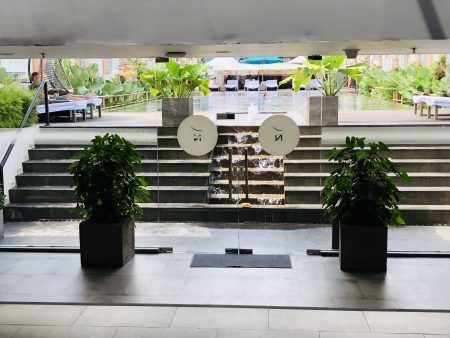

My room! These photos don’t do it justice. I was immediately soothed by the atmosphere. It felt like entering a gaijin house.



He was correct; I had a wonderful sleep. The sheets were OMG!



In the morning, I went for breakfast before most of the other guests were awake.
[image error]
No, I didn’t eat the pastry. I wanted to!
[image error]
The food counters just went on and on and on. Most of what was offered, I can’t pronounce. I tried a little of most everything. Where I recognized it might possibly be raw fish, I kept walking. The entire dining area was a wonderful introduction to the delicious world of Bali cuisine.
As for the hotel, I had a lovely time. It’s a beautiful and restful atmosphere. After breakfast, I went outside and took photos. The flowers were spectacular. Monkey statues were everywhere. I learned later why that is. The people believe that many souls are temporarily reincarnated into monkeys on their way somewhere else; so just in case, the monkey temples are there to remind us that there is a spiritual connection them and us. I did see a monkey in Ubud who looked familiar. He strongly resembled my big brother — who I must add is alive and kicking in the Yukon.


All and all, it was a nice day, around 25 Celcius. My driver picked me at noon in a new SUV; I can’t remember what make. The drive to Ubud was fascinating. While there are similarities to Nayarit, I saw architecture, flowers, and landscape like nothing I’ve seen in North America.



Next month I’ll post about the drive, my stay at the Blooming Lotus Bliss Yoga retreat in Ubud, and all the wonderful people I met. There were 26 of us from all walks of life. I may have to make two posts. Lots happened.
Happy IWSG Wednesday, Everyone! Please be sure to visit our hosts Pat, Janet, and Natalie. Thanks.


IWSG was created by Ninja Captain Alex J Cavanaugh — because Alex understands we need a safe place to congregate, insecurity is part of our creative nature, and together we’re stronger.
On the first Wednesday of each month, you can write on any subject related to your writing journey or adopt the option of answering the month’s question. Either way, you’re in safe territory.
If this sounds like a good place to be, sign up here.
IWSG’s Twitter handle is @TheIWSG and hashtag is #IWSG.
Every month, a question is announced that members can answer in their IWSG post. These questions may prompt you to share advice, insight, a personal experience or story. Include your answer to the question in your IWSG post or let it inspire your post if you are struggling with something to say.
Remember, the question is optional!
June 3 question – Writers have secrets! What are one or two of yours, something readers would never know from your work?The awesome co-hosts for the June 3 posting of the IWSG are Pat Garcia, J.Q. Rose, and Natalie Aguirre!–namaste
joylene
The post June 2020 – IWSG: Tuban, Kuta, Bandung, Bali appeared first on Joylene Nowell Butler.
May 31, 2020
LOST HELIX by Scott Coon
This is a big shoutout for Scott Coon and the release of his newest novel LOST HELIX. I hope you’ll take the time to check it out. Congratulations, Scott!
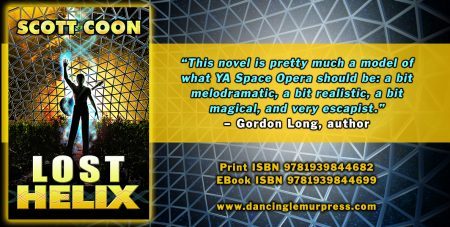
Lost Helix
By Scott Coon
Lost Helix is the key…
Stuck on an asteroid mining facility, DJ dreams of writing music. His dad is a corporate hacker and his best friend Paul intends to escape to become a settler in a planet-wide land rush, but neither interests DJ.
When his dad goes missing, DJ finds a file containing evidence of a secret war of industrial sabotage, a file encrypted by his dad using DJ’s song Lost Helix. Caught in a crossfire of lies, DJ must find his father and the mother he never knew.
When the mining company sends Agent Coreman after DJ and his guitar, DJ and Paul escape the facility and make a run for civilization. Will DJ discover the truth before Coreman catches him?
Release date – June 2, 2020
$17.95, 6×9 trade paperback, 268 pages
Print ISBN 9781939844682 / EBook ISBN 9781939844699
Science Fiction – Action & Adventure(FIC028010) / Crime & Mystery(FIC028140) / YA Science Fiction(YAF056000)
Scott Coon has enjoyed success as a science fiction short story writer, winning accolades and publishing over a dozen works in various magazines. Formally a U.S. Army Intelligence Analyst and currently a software developer, Scott brings his technical experience into his work, along with a sense of spectacle.
http://www.scottcoonscifi.com/
http://www.losthelix.com/
Links:
Amazon – https://www.amazon.com/Lost-Helix-Scott-Coon/dp/1939844681
Barnes & Noble – https://www.barnesandnoble.com/w/lost-helix-scott-coon/1135144023?ean=9781939844682
iTunes – https://books.apple.com/ca/book/lost-helix/id1490128516
Kobo – https://www.kobo.com/us/en/ebook/lost-helix
Goodreads – https://www.goodreads.com/book/show/50386208-lost-helix

The post LOST HELIX by Scott Coon appeared first on Joylene Nowell Butler.



